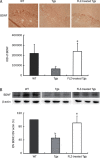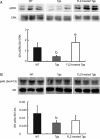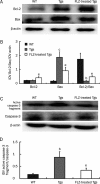The novel squamosamide derivative FLZ enhances BDNF/TrkB/CREB signaling and inhibits neuronal apoptosis in APP/PS1 mice
- PMID: 20154710
- PMCID: PMC4002416
- DOI: 10.1038/aps.2010.3
The novel squamosamide derivative FLZ enhances BDNF/TrkB/CREB signaling and inhibits neuronal apoptosis in APP/PS1 mice
Abstract
Aim: The aim of this study was to study the effects of compound FLZ, a novel cyclic derivative of squamosamide from Annona glabra, on brain-derived neurotrophic factor (BDNF)/tropomyosin receptor kinase B (TrkB)/cAMP response element-binding protein (CREB) signaling and neuronal apoptosis in the hippocampus of the amyloid precursor protein (APP)/presenilin-1 (PS1) double transgenic mice.
Methods: APP/PS1 mice at the age of 5 months and age-matched wild-type mice (WT) were intragastrically administered FLZ (150 mg/kg) or vehicle [0.05% carboxymethyl cellulose sodium (CMC-Na)] daily for 20 weeks. The levels of BDNF in the hippocampus of WT and APP/PS1 mice were then measured by immunohistochemistry and Western blot analysis. Neuronal apoptosis in mouse hippocampus was detected by Nissl staining. Expression of NGF, NT3, pTrkB (Tyr515)/TrkB, pAkt (Ser473)/Akt, pERK/ERK, pCREB (Ser133)/CREB, Bcl-2/Bax, and active caspase-3 fragment/caspase-3 in the hippocampus of WT and APP/PS1 mice was detected by Western blot analysis.
Results: Compared with vehicle-treated APP/PS1 mice, FLZ (150 mg/kg) significantly increased BDNF and NT3 expression in the hippocampus of APP/PS1 mice. In addition, FLZ promoted BDNF high-affinity receptor TrkB phosphorylation and activated its downstream ERK, thus increasing phosphorylation of CREB at Ser133 in the hippocampus of APP/PS1 mice. Moreover, FLZ showed neuroprotective effects on neuronal apoptosis by increasing the Bcl-2/Bax ratio and decreasing the active caspase-3 fragment/caspase-3 ratio in the hippocampus of APP/PS1 mice.
Conclusion: FLZ exerted neuroprotection at least partly through enhancing the BDNF/TrkB/CREB pathway and inhibiting neuronal apoptosis in APP/PS1 mice, which suggests that FLZ can be explored as a potential therapeutic agent in long-term Alzheimer's disease therapy.
Figures







Similar articles
-
FLZ alleviates the memory deficits in transgenic mouse model of Alzheimer's disease via decreasing beta-amyloid production and tau hyperphosphorylation.PLoS One. 2013 Nov 4;8(11):e78033. doi: 10.1371/journal.pone.0078033. eCollection 2013. PLoS One. 2013. PMID: 24223757 Free PMC article.
-
Icariside II, a Phosphodiesterase-5 Inhibitor, Attenuates Beta-Amyloid-Induced Cognitive Deficits via BDNF/TrkB/CREB Signaling.Cell Physiol Biochem. 2018;49(3):985. doi: 10.1159/000493232. Epub 2018 Sep 7. Cell Physiol Biochem. 2018. PMID: 30196289
-
Osthole Upregulates BDNF to Enhance Adult Hippocampal Neurogenesis in APP/PS1 Transgenic Mice.Biol Pharm Bull. 2015;38(10):1439-49. doi: 10.1248/bpb.b15-00013. Biol Pharm Bull. 2015. PMID: 26424009
-
The Role of Brain-Derived Neurotrophic Factor as an Essential Mediator in Neuronal Functions and the Therapeutic Potential of Its Mimetics for Neuroprotection in Neurologic and Psychiatric Disorders.Molecules. 2025 Feb 12;30(4):848. doi: 10.3390/molecules30040848. Molecules. 2025. PMID: 40005159 Free PMC article. Review.
-
Medicinal Herbs and Their Derived Ingredients Protect against Cognitive Decline in In Vivo Models of Alzheimer's Disease.Int J Mol Sci. 2022 Sep 25;23(19):11311. doi: 10.3390/ijms231911311. Int J Mol Sci. 2022. PMID: 36232612 Free PMC article. Review.
Cited by
-
The Effect of Electroacupuncture versus Manual Acupuncture through the Expression of TrkB/NF-κB in the Subgranular Zone of the Dentate Gyrus of Telomerase-Deficient Mice.Evid Based Complement Alternat Med. 2018 Apr 22;2018:1013978. doi: 10.1155/2018/1013978. eCollection 2018. Evid Based Complement Alternat Med. 2018. PMID: 29849690 Free PMC article.
-
PACAP protects against salsolinol-induced toxicity in dopaminergic SH-SY5Y cells: implication for Parkinson's disease.J Mol Neurosci. 2013 Jul;50(3):600-7. doi: 10.1007/s12031-013-0015-7. Epub 2013 Apr 28. J Mol Neurosci. 2013. PMID: 23625270 Free PMC article.
-
Non-invasive Brain Delivery and Efficacy of BDNF in APP/PS1 Transgenic Mice as a Model of Alzheimer's Disease.Med Res Arch. 2020 Feb;8(2):2043. doi: 10.18103/mra.v8i2.2043. Med Res Arch. 2020. PMID: 32551362 Free PMC article.
-
Neuroprotection by Cerebrolysin and Citicoline Through the Upregulation of Brain-Derived Neurotrophic Factor (BDNF) Expression in the Affected Neural Cells: A Preliminary Clue Obtained Through an In Vitro Study.Cureus. 2024 Feb 21;16(2):e54665. doi: 10.7759/cureus.54665. eCollection 2024 Feb. Cureus. 2024. PMID: 38524067 Free PMC article.
-
Puerarin Attenuates the Cytotoxicity Effects of Bisphenol S in HT22 Cells by Regulating the BDNF/TrkB/CREB Signaling Pathway.Toxics. 2025 Feb 25;13(3):162. doi: 10.3390/toxics13030162. Toxics. 2025. PMID: 40137489 Free PMC article.
References
-
- Scinto LF, Wu CK, Firla KM, Daffner KR, Saroff D, Geula C. Focal pathology in the Edinger-Westphal nucleus explains pupillary hypersensitivity in Alzheimer's disease. Acta Neuropathol. 1999;97:557–64. - PubMed
-
- Auld DS, Kornecook TJ, Bastianetto S, Quirion R. Alzheimer's disease and the basal forebrain cholinergic system: relations to beta-amyloid peptides, cognition, and treatment strategies. Prog Neurobiol. 2002;68:209–45. - PubMed
-
- Schliebs R, Arendt T. The significance of the cholinergic system in the brain during aging and in Alzheimer's disease. J Neural Transm. 2006;113:1625–44. - PubMed
-
- Coleman PD, Yao PJ. Synaptic slaughter in Alzheimer's disease. Neurobiol Aging. 2003;24:1023–7. - PubMed
-
- Okamura N, Suemoto T, Shiomitsu T, Suzuki M, Shimadzu H, Akatsu H, et al. A novel imaging probe for in vivo detection of neuritic and diffuse amyloid plaques in the brain. J Mol Neurosci. 2004;24:247–55. - PubMed
MeSH terms
Substances
LinkOut - more resources
Full Text Sources
Medical
Research Materials
Miscellaneous

